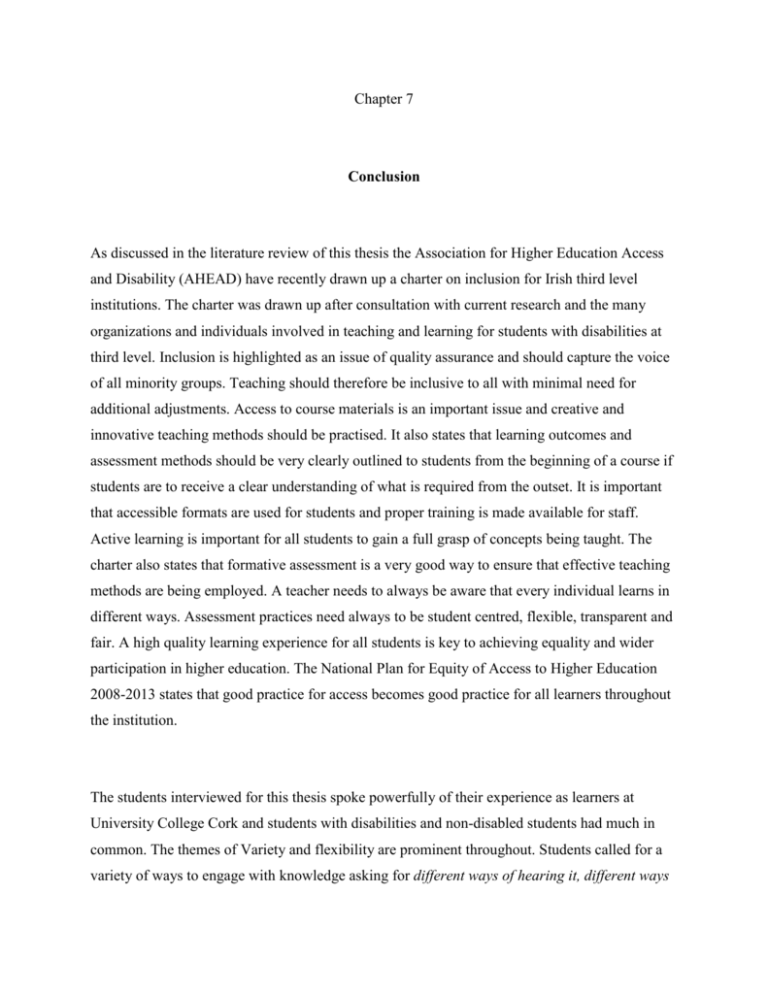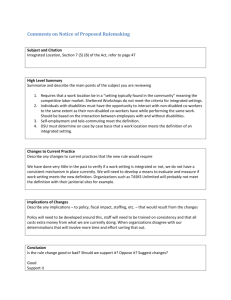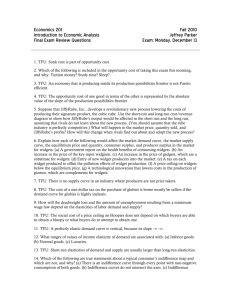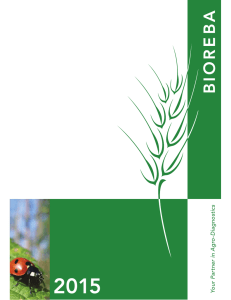Conclusion - University College Cork
advertisement

Chapter 7 Conclusion As discussed in the literature review of this thesis the Association for Higher Education Access and Disability (AHEAD) have recently drawn up a charter on inclusion for Irish third level institutions. The charter was drawn up after consultation with current research and the many organizations and individuals involved in teaching and learning for students with disabilities at third level. Inclusion is highlighted as an issue of quality assurance and should capture the voice of all minority groups. Teaching should therefore be inclusive to all with minimal need for additional adjustments. Access to course materials is an important issue and creative and innovative teaching methods should be practised. It also states that learning outcomes and assessment methods should be very clearly outlined to students from the beginning of a course if students are to receive a clear understanding of what is required from the outset. It is important that accessible formats are used for students and proper training is made available for staff. Active learning is important for all students to gain a full grasp of concepts being taught. The charter also states that formative assessment is a very good way to ensure that effective teaching methods are being employed. A teacher needs to always be aware that every individual learns in different ways. Assessment practices need always to be student centred, flexible, transparent and fair. A high quality learning experience for all students is key to achieving equality and wider participation in higher education. The National Plan for Equity of Access to Higher Education 2008-2013 states that good practice for access becomes good practice for all learners throughout the institution. The students interviewed for this thesis spoke powerfully of their experience as learners at University College Cork and students with disabilities and non-disabled students had much in common. The themes of Variety and flexibility are prominent throughout. Students called for a variety of ways to engage with knowledge asking for different ways of hearing it, different ways of learning it (student 4). Discussion in the classroom was viewed by students as essential to ensure digestion of knowledge and reading prior to a class was viewed as important to ensure informed discussion. One student was totally underwhelmed by the lack of discussion in a third level classroom. The teaching for understanding model of teaching allows a teacher by means of discussion and formative assessment know exactly where the students are in their learning journey, thus making it possible to know whether the threshold concepts required to bring the students to the next level of learning have been achieved. Informed discussion creates a performance of understanding in which the students have the opportunity to demonstrate and consolidate their knowledge before moving on to the next level of learning in the TFU ladder of naive, novice, apprentice or master. A learning environment can be created where students cease to take knowledge for granted and leave behind a tendency to draw on intuitive beliefs. They begin to see how knowledge is created in the domain and to question their own and others thinking. By drawing on the discipline they learn how to take ownership of knowledge by basing argument upon method rather than intuitive thinking. The TFU model also assists a teacher to draw upon a variety of forms to encourage a performance of understanding in the students. These are performances that use a range of symbol systems to portray knowledge in effective and creative ways. Facilitated discussion of knowledge between the members of a class can include the purpose dimension of the TFU model by providing many examples of applying knowledge, thus demonstrating how enquiry is driven in the domain. The TFU model will provide a variety and flexibility by opening up many entry points to learning and also serve a multiple range of intelligences. Group work is good to introduce students to the skills necessary to work as part of a team. The TFU teacher can draw on group work to expand the knowledge of a student and employ it as a method important to the development of a student’s interpersonal skills. Knowledge can also be introduced to the students in different forms to help reach out to the variety of intelligences operating within each student, thus allowing each student bring their own particular strengths to the project concerned. Student A and student B spoke strongly on this issue. It is true that some of the students were nervous of fellow students not pulling their weight, but other students suggested the use of small groups to help avoid this. It may also help to only use group work for formative assessment and not for summative assessment as this offers no real threat to students taking part in a group project. Evidence also showed that students with serious and visible disabilities found group work helpful to break social barriers that exist due to social perceptions acquired by their fellow students. The importance of breaking down social barriers such as these cannot be underestimated. A happy and well integrated student is in a far better position to learn. The importance of breaking down social barriers is also an issue for many non-disabled students who are shy to approach others and slow to make friends. Group work provides a great opportunity to develop interpersonal skills, which are of crucial importance whatever career path a student may take. Employing off campus learning as a method of teaching was viewed as positive by most students. Students claimed that putting theory into action was a great way of helping to understand and develop upon the important concepts of a program of study. It gives the teacher the opportunity to use many forms in bringing on a students’ knowledge and creates the opportunity for many different entry points to learning. Viewing theory in action is also the most effective way of creating purpose for knowledge understood by a student and opens up the student’s mind to the questions, purposes and interests that drive enquiry in the domain. The Internet is a very flexible medium for the TFU teacher willing to draw upon the advantages of modern technology. It allows a teacher address various levels of knowledge via many innovative methods and by being free to present knowledge in many different forms. This makes it easier for the TFU teacher to instil a good sense of purpose as knowledge and concepts are developed. The use of Blackboard was viewed positively by all students and the provision of notes on Blackboard was welcomed by students with disabilities and non-disabled student alike. The majority of students with disabilities are well trained in the use of assistive technology and depend greatly on accessing most of their knowledge via this medium. Non-disabled students claimed the reception of notes via Blackboard was good for graphical material, for revision at exam time and to help avoid distraction during a lecture when having to take notes. Students with disabilities, however, valued notes on Blackboard with additional reasons. Receiving their notes via Blackboard was not just something that made learning easier, but was essential to the student’s survival as a learner. Student B described Blackboard as the lifeblood of his course. Student C explained that not being trained in the use of Blackboard became a major disadvantage to her during her studies. Both students with disabilities and non-disabled students also praised teachers who were willing to put their lecture notes up on Blackboard prior to a lecture. This practice helped students prepare for class and be better placed for class discussion. This must also be of particular benefit to a student whose first language is not English. Not having class materials can create a great sense of exclusion for students with disabilities. If a teacher wishes to create a seminar experience or a class discussion based upon a handout or material presented via PowerPoint during class the student with a print disability such as the blind, visually impaired or seriously dyslexic student will not be able to take part and will soon be lost to the class. If the material is provided prior to a class the student is in a position to prepare by reading the material and by bringing it to class with them on their assistive technology. Teachers who provided reading material via Blackboard were also praised by both groups of students. Non-disabled students claimed that particular texts were extremely difficult to access via the library when many students were looking for the same text. Being able to access important course texts via Blackboard meant that many students were not clamouring for the same material at the same time. Students with disabilities said it was a very accessible method of accessing reading material. Accessibility was a term used by both groups of students when discussing the availability of reading material via Blackboard. The use of the electronic sources in the Boole Library was also praised by students and this along with Google Books was welcomed as a good way of accessing reading material. Conducting discussion groups on the Internet was also discussed in the interviews, but the majority of students did not take part either because it was not provided or because it was not compulsory and they did not have the time. Student 5 did, however take part in a well organized discussion, which was part of a funded pilot project. This student claimed that the use of Internet discussion did create discussion that might not otherwise have taken place in the classroom. Access to the discussion was open to students and facilitator and was based upon readings provided by the teacher. Not having to speak face to face and having time to reflect before speaking were the reasons put forward by the student for an extra level of discussion. He said people took part who would not normally take part in a face to face discussion. Students were, however, assessed on their participation so there was a greater incentive to become involved. The student did indicate that problems can exist for mature students and that these would need to be addressed. Plans would also need to be put in place to ensure that the software being employed was compatible with the assistive technology of students with disabilities. When properly organized an informed Internet discussion with a high participation rate is an ideal method of learning to create a performance of understanding in which students can be seen to take ownership of knowledge and apply it in a meaningful way. The opportunity to reflect and contribute in one’s own time provides a student with the space to draw upon the discipline and use clear method when creating an argument or making a point. Assessment is when a student is given the opportunity to perform with knowledge and demonstrate ownership of the concepts and skills that make up the learning outcomes of their course. Course assessment can also, however, provide opportunities for a teacher to encourage and direct a student in their learning. The interviews are evidence of a strong awareness among students that continuous assessment is a good opportunity for learning. Comments and advice provided through an assessment are opportunities for one to one teaching and learning to take place and are valued as such. Students who just received a mark felt that they had been provided with no direction to help them improve in the future. It is important that assignments are designed to allow a student perform with their newly acquired knowledge and show their understanding of key concepts on their course. It may take imagination to create assignments to accommodate the variety of intelligences operating within each student as they strive to grasp and perform with knowledge and concepts. The amount of variety in assessment experienced by students varied, but all language students experienced a lot of variety due to the nature of their subjects. Student D made the point that the use of variety in language subjects was not to accommodate students, but simply a case of accommodating the subject matter. Student 5 was not a language student and did experience a great range of variety in his assessments. He was particularly enthused by an Internet blog which was assessed. This was an opportunity for reflective learning and it could be commented on by both teacher and peers. He said it provided opportunities for peer learning and collaboration of ideas. He also said it was useful in helping a student realize where their knowledge was weakest. It is in creating a point or argument that a student will discover weaknesses in their ability to perform with knowledge and method within the domain. Student C also experienced a reflective learning journal, which was assessed, but this was not conducted on the Internet and was private to student and teacher. This consisted of a journal kept throughout the course and though the student said he did not like it at the time it did prove very beneficial. It provided the opportunity to reflect on the learning journey and was very useful for revision. Though teachers experience a certain amount of restriction when planning the assessment of a module, there is still room for much variety in assessment. Formative assessment is important and students appreciate greatly the opportunity to learn through assessment feedback. It is important that assessment be based upon the learning outcomes of a program of study and important that learning outcomes and assessment procedures be clearly outlined to students early in the academic year. Some of the students interviewed were happy with this while others were quite dismayed with the lack of information. Student 1 found things particularly difficult in one of her courses and describes great confusion in the class. Student B describes a particularly confusing year in first year and when this was combined to the stresses of his disability he claims he nearly ended up in hospital. The TIC project provides a template course booklet for the staff at Trinity College to help departmental staff lay out a course booklet that will clearly present all information pertaining to a course of study including learning outcomes and assessment methods. This type of approach combined with a clearly designed induction lecture should make a big difference to informing a student with regard to their learning outcomes and assessment methods. It is important that information is available to students with disabilities and should therefore be available both in hard copy and on-line in a clear and correctly formatted style. The literature review of the thesis discussed the work being carried out by disability support services within colleges and the increased workload and financial drain as a result of increasing numbers of students registered with the services. It is becoming unsustainable to provide accommodations for increasing numbers and this is exacerbated at a time of economic difficulty. Adopting a model of disability support based primarily upon accommodations is also contrary to the social model of disability and is not in accordance with a policy of universal design. All students will not experience inclusion until teaching methods are adopted to serve all students disabled and non-disabled alike. This could eliminate or at the very least diminish a large degree of support provided by disability support services such as note takers, the provision of alternative format, educational assistants etc. The interviews in this thesis show non-disabled students and students with disabilities alike calling for greater variety and flexibility in teaching and assessment. Teachers who invest in the scholarship of teaching and learning focus on looking for the evidence of student learning and as a result improve their teaching skills by reflecting upon their own practice. The interviews in this thesis make learning visible by breaking it into its constituent parts, thus offering opportunities for teachers to reflect upon their own teaching skills. Multiple Intelligences theory and Teaching for Understanding help teachers to take a SOTL lens because they name all the parts of teaching and learning. My interviews with the students gave me an opportunity to research teaching and learning and map out what students want. They also highlights student awareness of the lack of teacher training in the third level sector. Using the Teaching For Understanding model and informing pedagogy via Multiple Intelligences theory has the potential to serve all students well by encouraging a SOTL approach and by promoting an inclusive learning experience in the third level classroom. It is appropriate to conclude with a quotation from Ernest Boyer: Teaching is also a dynamic endeavour involving all the analogies, metaphors and images that build bridges between the teacher’s understanding and the student’s learning. Pedagogical procedures must be carefully planned, continuously examined, and relate directly to the subject being taught....knowing and learning are communal acts. With this vision, great teachers create a common ground of intellectual commitment. They stimulate active, not passive, learning and encourage students to be critical, creative thinkers, with the capacity to go on learning after their college days are over (Boyer, 1990, 23-24).






